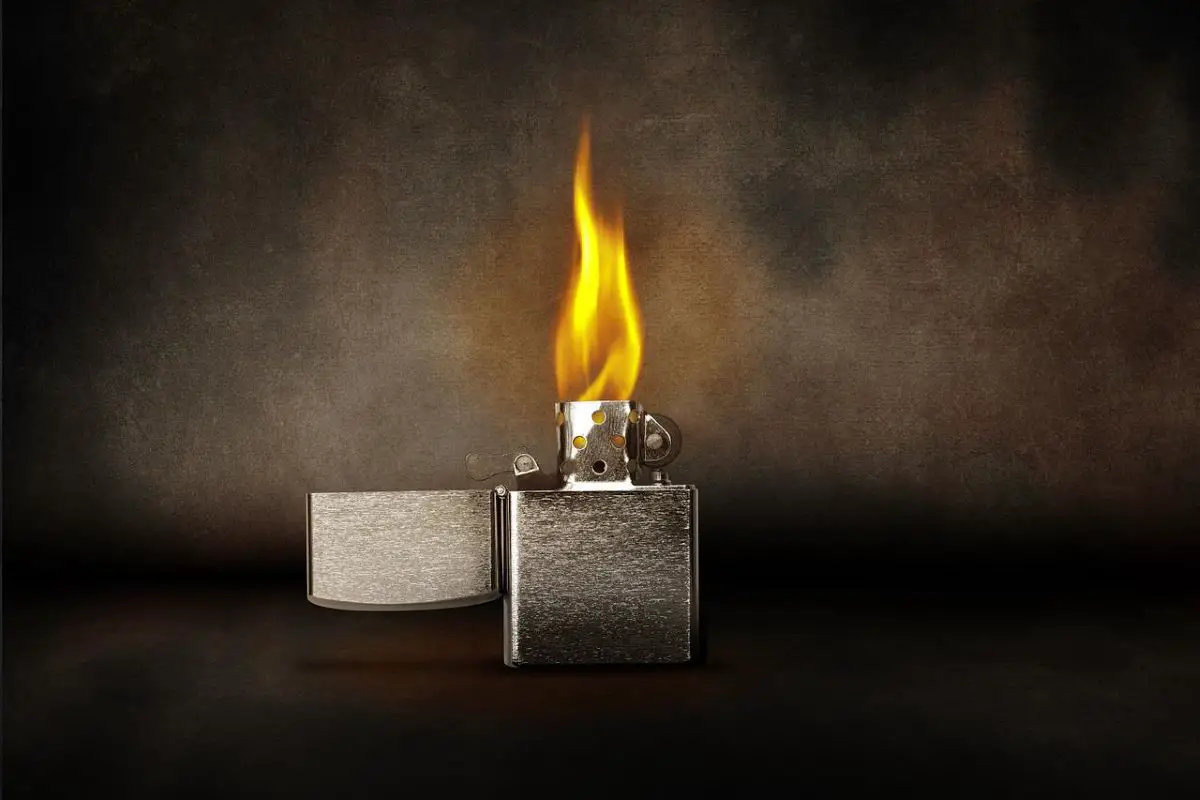Packing for flights can be a bit of a pain these days, as the list of items you can and cannot bring grows more extensive. We know flammable items are not allowed on planes, but what about a lighter? Can you take a lighter on a plane?
Yes, you can carry along a lighter on a plane. However, per TSA’s rules, only ‘generic lighters’ are allowed as carry-on. That means your regular plastic Bic lighter or Zippo may be ok. However, electronic or plasma lighters may not be acceptable. The rules may change, so it might be best to check directly with the TSA.
This article will explore if you can bring a lighter on a plane and other fire and smoking-related paraphernalia such as vapes, cigarettes, or matches.
We also reveal other surprising items you may bring up onto a plane. If you have some items you are unsure of, we also show where you can check for the latest regulations from TSA (Transportation Security Agency).
Can You Take A Lighter On A Plane?
Only certain types of lighters are allowed. At the time of writing, TSA allows ‘common lighters,’ which would probably mean regular plastic lighters, such as those from Bic. Butane-torch lighters such as those from Zippo are also ok. However, electronic or plasma lighters or oddly shaped lighters may not pass TSA checks.
It is rather odd, but TSA allows lighters, even though they are flammable. There are, of course, caveats to this. There are also differences in allowances for lighters when bringing them as part of your carry-on luggage or checked-in luggage.
You may like this article: Can You Bring A Skateboard On A Plane?
Carry-On Bags
TSA currently allows disposable plastic lighters as carry-ons. Lighters with liquid fuel and lining, such as Zippo, are also allowed as carry-on, but they must not have fuel inside. This means you may need to remove the fuel or the cotton pieces that hold the fuel.
However, in certain situations, you may be allowed to bring your lighter with fuel. But they must adhere to the Department of Transportation’s regulation, meaning the fuel must be enclosed in a DOT (Department of Transportation) approved case.
Other types of lighters are not allowed. That means leaving your plasma, arc, electric, and electronic lighters home. Also, never try your luck with odd-shaped lighters, especially those that resemble a weapon.
You cannot bring your lighter out in the open throughout the flight, as it may be seen as threatening and a hazard on planes. Keep them in your bags or in your pocket at all times.
Checked In Bags
TSA does not allow any types of lighters with fuel in a piece of checked luggage unless they are empty.
Make sure your lighters are totally empty before checking them in. This is because TSA can be pretty thorough with their work and may disallow your lighters even if only a few drops of liquid fuel are in them.
This is because it is a fire risk. It is understandable for the TSA to think so. Luggage storage in planes is probably packed full of clothes and suitcases, and planes may shake as it flies and the luggage.
If the shaking triggered the lighters and started a spark, it may catch the fuel and start a fire. The fire can grow fast with all the clothes inside these suitcases.
Can You Bring Matches On A Plane?
TSA currently allows only a single book of safety matches as carry-on. The matches should always be kept away and not taken out, as they may be threatening to other passengers. Attempting to use it may result in criminal charges. Matches are not allowed in checked-in bags since they can be a fire hazard.
Carry On Bags
TSA allows one book of safety matches. Any more than that may cause TSA to suspect something sinister and may just decide to confiscate all of them. Like lighters, you do not want to bring them out in the open, let alone try to use them.
Starting a fire in a plane can easily result in you being restrained by the crew and other passengers and may result in criminal charges pressed against you once the plane lands. Just keep them packed tight throughout the flight. It’s not like you can smoke anyway.
Checked In Bags
TSA does not allow any safety matches for checked-in bags. The reason may be similar to lighters since suitcases are usually packed with clothes and can easily feed a fire.
Matches can be lit accidentally if they rub against each other frequently, which may happen since planes might be shaking at times, especially through turbulence. Removing matches from checked-in bags is a good safety precaution.
Can You Bring Vape On A Plane?
Carry-On Bags
TSA allows you to bring your vape with your carry-on bags. Perhaps this allows them to inspect it and also to allow you to bring it around since you can’t put them in your checked-in luggage.
However, this is also contingent on you taking the necessary precaution to avoid accidental activation of the heating element inside the vape. This may mean you want to separate the battery from the heating element before presenting it to TSA officers to inspect it.
The battery for your vape must also not exceed a Watt-hour (Wh) rating of 100Wh. It must also not have more than 2 grams of lithium content.
Like lighters and matches, you should always keep them out of sight and not bring them out in the open. Attempting to vape is also wrong, as the vapor can easily be mistaken for smoke and fire.
Checked-In Bags
Vapes are not allowed in checked-in bags. The reason may be that the TSA needs to be able to visually inspect the vape, which means they should be brought onto the plane as a carry-on.
If they can inspect it, they can confirm there is nothing sinister about the vape. The TSA can also visually confirm that the battery has been separated from the heating element, reducing the fire risk.
Another probable reason is that TSA needs to make sure you have taken the precautionary step of separating the heating element from the battery to avoid accidental activation. This may either start a fire inside the luggage storage area in the plane or produce vapors that look like smoke.
Can You Bring Cigarettes and Cigars On A Plane?
TSA allows you to bring most tobacco-related products on a plane, as both carry-on and checked-in luggage. However, different countries have regulations on how many units of tobacco products you can bring into the border, so you should confirm these before traveling.
TSA allows tobacco-related products on planes, including cigarettes, cigars, and chewing or sniffed tobacco. You can bring them on as both carry-on or checked-in luggage.
However, tobacco products are highly regulated by many border agencies worldwide. Many countries regulate how many sticks of cigarettes or cigars you can bring into their country, with some regulating the weight of tobacco as well.
You may want to check and confirm the allowance before traveling to your destination to avoid having these items confiscated at the border checkpoint. The US allows up to 200 sticks of cigarettes and up to 100 sticks of cigars.
Of course, you may not want to light up these tobacco products on the plane, as that would be akin to starting a fire. You may be restrained by the airplane crew and have charges pressed against you.
Are There Other Surprising Items Allowed On A Plane?
You may be allowed to bring potentially hazardous items on board, such as some scissors, nail clippers, knitting needles, and specific hand tools such as screwdrivers or pliers. However, the allowances also contain many caveats. You might want to confirm the details before taking them on a flight.
Some items that you may think are contraband are surprisingly allowed. These items, however, come with more minor regulations that you may want to check and confirm first, to avoid confiscation at the TSA checkpoints.
Hand Tools
Certain hand tools such as screwdrivers, pliers, or wrenches are allowed as check-in or carry-ons, provided that they are less than seven inches in length. If they are longer than seven inches, they must be checked in. This is logical since longer tools can easily be turned into a weapon.
Scissors
Scissors are also allowed for flights, despite them being sharp. However, they must be shorter than four inches from their pivot point to tip to be allowed in as a carry-on. Anything longer and they must be packed in as part of your checked-in luggage. They should also be sheathed to avoid injury to TSA officers and baggage handlers.
Nail Clippers
Nail clippers are also allowed on flights as part of a carry-on or checked-in luggage. However, they must be sheathed to avoid injuring baggage handles or TSA inspectors.
Knitting Needles
TSA allows knitting needles on planes as part of a carry-on or checked-in luggage. However, like scissors and nail clippers, knitting needles are sharp objects that may hurt baggage handlers and TSA officers. Which means you should keep them sheathed.
You may like this article: How Old Do You Have To Be To Buy Lighters?
Where Can I Go To Check For The Newest TSA Regulation?
You may visit TSA’s website (tsa.gov) for the latest information and regulation on what you can or cannot bring up on flights. In the ‘What Can I Bring’ section, simply type in the item you have in mind, and see if TSA has any rules about the item.
The great thing about TSA (Transportation Security Agency) is that they are not opaque about the regulation of what is allowed or not allowed in planes.
If you have doubts about specific items you want to bring on your next flight, visit the TSA’s website at the ‘What Can I Bring’ section. Simply type in the item you have in mind, and you can get a clear answer immediately from TSA about its status.
However, understand that the final decision resides with the TSA officers at the security checkpoint.
They may mean that even if the item is allowed on the list, the TSA officer may disallow it. TSA officers have the power to disallow items on planes if the officer believes that removing the item protects other passengers.
 Being Human
Being Human





